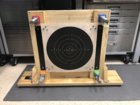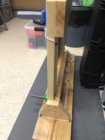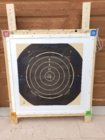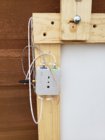I currently have 10 ShotMarkers for my club but as we refine our target frames this year (our 1st full year with any ET's) we will be developing a way to mount the wires to the target frames.
This will make set up and take down faster, just as fast as the old days when you put the target frame in the carrier and wallpaper pasted a paper target on it. Should also save any wear and tear on the cables because they won't be removed and coiled up to be stored in the handy cases the sensors go in each time they are set up or put away.
The way we built our frames they are light enough that one person can easily grab them out of the target shed by themselves, put it in the carrier, pop the 4 sensors on and connect the 4 wires to the sensor hub in about 3- 4 minutes per target. ( I would imagine about the same for Solo users )
Our initial thought is to secure the cables to the frames in a way that they can stay on the frames and go in and out of the target shed when not in use without getting damaged. Some sort of J channel like this maybe https://www.electriduct.com/J-Channel.html
Our target shed is a little tight for storage with 16 of the old foam board targets for paper targets that will still be used from time to time to the left and the 10 wood ShotMarker frames to the right so we have to be a little careful to not beat up the sensor brackets when sliding the frames in and out of the storage shed when not in use. ( See pic )
Has anyone semi permanently mounted their cables ( Solo or ShotMarker Systems ) that could share methods, pictures or info?
I'm thinking this would be good info for clubs or individual users of these awesome new systems.
Thanks All,
George
This will make set up and take down faster, just as fast as the old days when you put the target frame in the carrier and wallpaper pasted a paper target on it. Should also save any wear and tear on the cables because they won't be removed and coiled up to be stored in the handy cases the sensors go in each time they are set up or put away.
The way we built our frames they are light enough that one person can easily grab them out of the target shed by themselves, put it in the carrier, pop the 4 sensors on and connect the 4 wires to the sensor hub in about 3- 4 minutes per target. ( I would imagine about the same for Solo users )
Our initial thought is to secure the cables to the frames in a way that they can stay on the frames and go in and out of the target shed when not in use without getting damaged. Some sort of J channel like this maybe https://www.electriduct.com/J-Channel.html
Our target shed is a little tight for storage with 16 of the old foam board targets for paper targets that will still be used from time to time to the left and the 10 wood ShotMarker frames to the right so we have to be a little careful to not beat up the sensor brackets when sliding the frames in and out of the storage shed when not in use. ( See pic )
Has anyone semi permanently mounted their cables ( Solo or ShotMarker Systems ) that could share methods, pictures or info?
I'm thinking this would be good info for clubs or individual users of these awesome new systems.
Thanks All,
George
Attachments
Last edited:



















